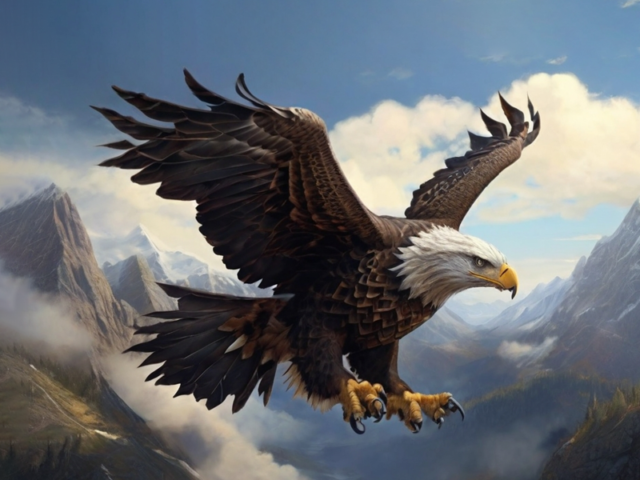In the realm of avian wonder, eagles stand as iconic symbols of power, freedom, and majesty. These magnificent birds of prey have fascinated humans for centuries with their awe-inspiring flight. One of the most common questions that arises in the minds of eagle enthusiasts is, “How high do eagles fly?” In this exploration, we’ll delve into the fascinating world of eagles and unravel the mysteries surrounding their soaring altitudes.
Understanding Eagle Flight:
Eagles, belonging to the family Accipitridae, are known for their impressive aerial capabilities. With broad wingspans and powerful muscles, they are built for efficient flight. The altitude at which eagles soar depends on various factors, including their species, geographical location, and the purpose of their flight.

Species Variations:
There are over 60 species of eagles, each with its unique characteristics and behaviors. The golden eagle (Aquila chrysaetos), for instance, is renowned for its remarkable soaring abilities. These birds are often spotted at altitudes ranging from 10,000 to 15,000 feet above sea level. On the other hand, the bald eagle (Haliaeetus leucocephalus), known as the national bird and symbol of the United States, tends to fly at lower altitudes, typically between 2,000 and 4,000 feet.
Thermals and Updrafts:
One key aspect of eagle flight is their utilization of thermals and updrafts. These rising air currents provide the necessary lift for eagles to ascend to higher altitudes effortlessly. Thermals are columns of warm air that ascend from the Earth’s surface, while updrafts are created when wind encounters a barrier such as a mountain, forcing the air to rise. Eagles skillfully navigate these air currents, conserving energy and allowing them to reach impressive heights.
Migration Patterns:
Migration plays a crucial role in determining the altitude at which eagles fly. Many eagle species are known for their extensive seasonal migrations, covering vast distances in search of suitable habitats and prey. During migration, eagles can reach staggering altitudes as they traverse mountains and navigate diverse terrains. Observing these majestic birds during migration offers a unique opportunity to witness their soaring capabilities.

The Record-Setting Flight:
To truly grasp the heights eagles can reach, it’s essential to explore some remarkable records set by these birds. In 1954, a golden eagle collided with a plane over Scotland at an astonishing altitude of 32,000 feet, setting the record for the highest documented eagle flight. This incident highlights the incredible heights these birds can attain, showcasing their adaptability to different environments.
Environmental Influences:
Environmental factors, such as wind patterns and air density, significantly impact eagle flight. In regions with strong and consistent winds, eagles may ride the currents for extended periods, reaching higher altitudes than in areas with calmer conditions. Additionally, higher altitudes with lower air density pose challenges for birds, requiring them to adjust their flight techniques to maintain stability.

Conservation Concerns:
While celebrating the extraordinary heights eagles can achieve, it’s crucial to address the conservation challenges they face. Habitat loss, pollution, and human interference pose threats to eagle populations worldwide. By understanding their flight behaviors and ecological needs, we can contribute to the conservation efforts aimed at preserving these majestic birds for future generations.
Conclusion:
In the ethereal realm where the sky meets the earth, eagles reign supreme as masters of the skies. The question, “How high do eagles fly?” opens a doorway to a world of wonder and discovery. From the golden eagles soaring over mountain ranges to the bald eagles gliding gracefully over lakes, these birds exemplify the art of flight. As we unravel the secrets of their aerial prowess, let us also embrace the responsibility to protect and preserve the habitats that allow these majestic creatures to reach unparalleled heights. In doing so, we ensure that the spirit of eagle flight continues to captivate and inspire generations to come.







